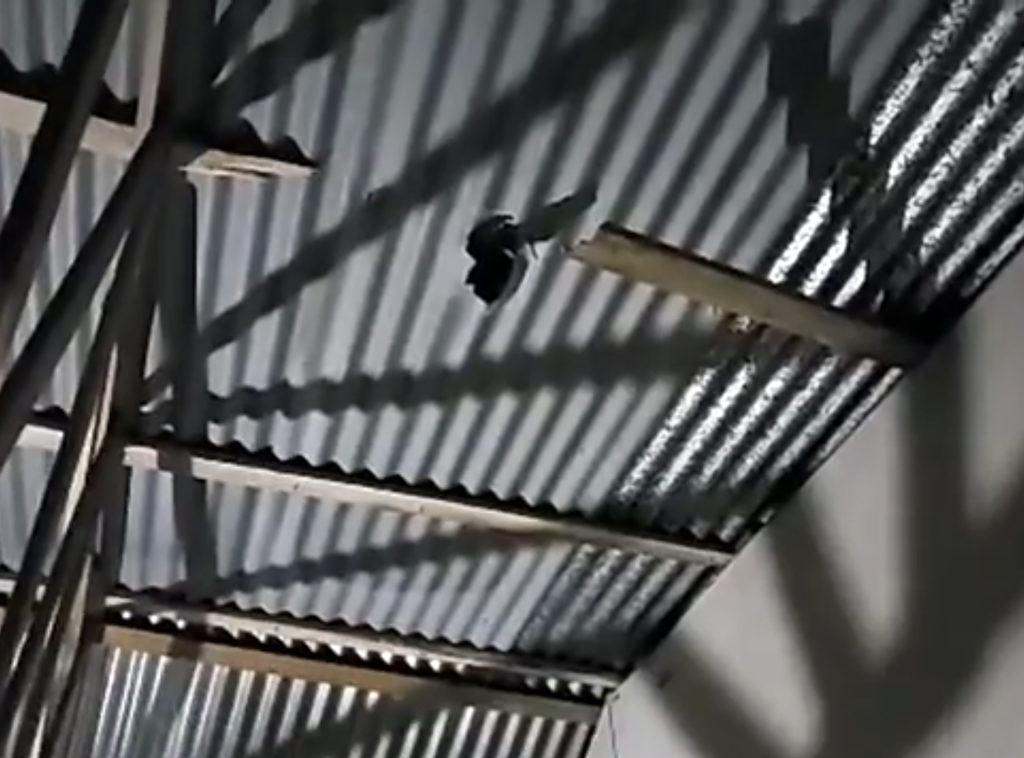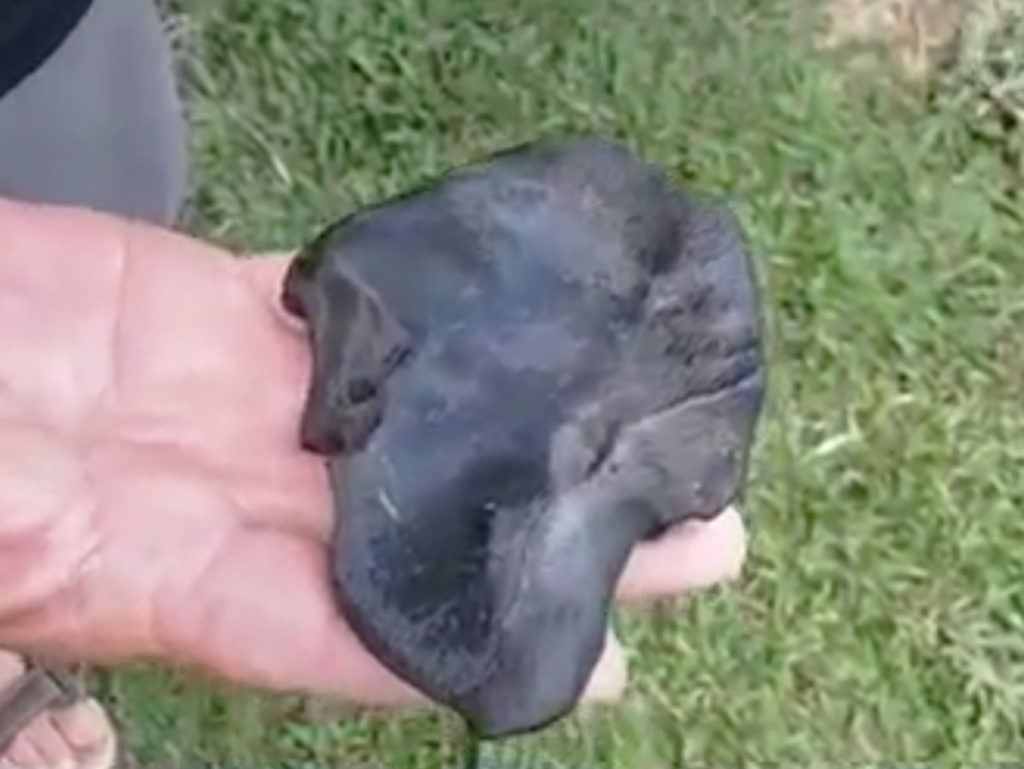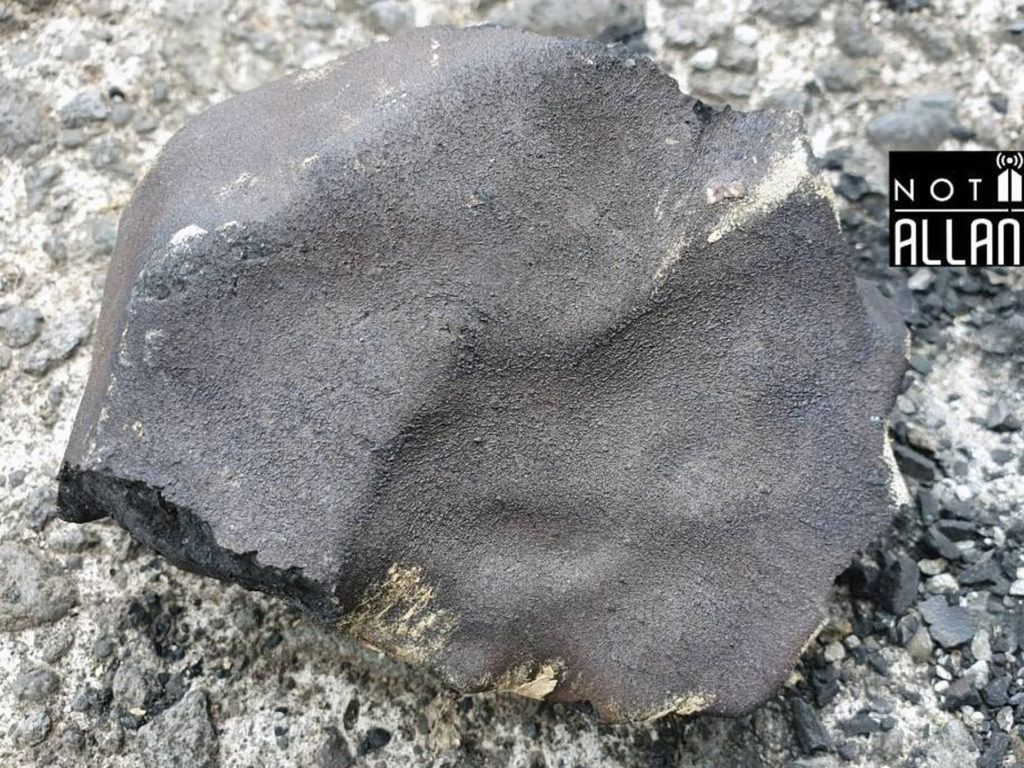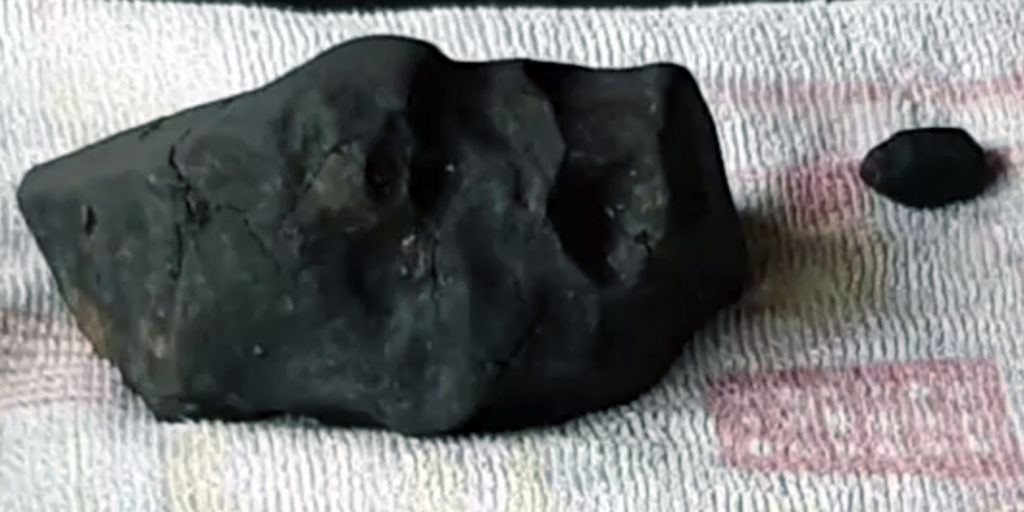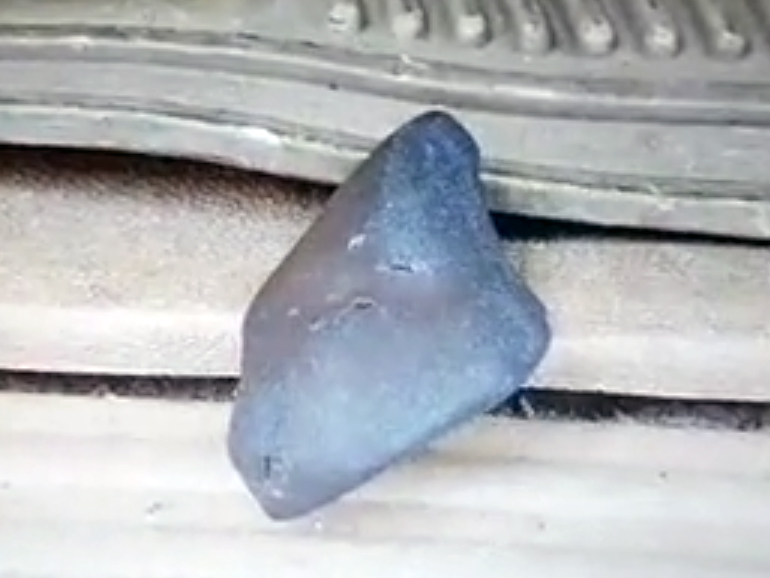Meteorite fall (~ 27 kg, CM2) in La Caporal, AGUAS ZARCAS and around Santa Rosa and La Palmera, San Carlos, Alajuela, Costa Rica on 23 April 2019 at ~ 9.07.22-26 p.m. CST (~3.07.22-26 UTC, 24 April)
Last update: 15 February 2020
On 23 April 2019 at about 9.07.22-26 p.m. CST (3.07.22-26 UTC, 24 April) a regmaglypted meteorite, a carbonaceous chondrite (CM-type), weighing about 1152 grams, fell through the corrugated zinc sheet of the western slope of the patio overhang at the northern backside of a house in La Caporal (10°23’28.8″N 84°20’28.5″W) in the district Aguas Zarcas. It split a cable and a wooden beam (~3x2x1 inches) of the roof structure and landed between two collapsible plastic tables which were stored vertically on the ground next to a wall at the backside of the house. At around 9.10 p.m. home owner Marcia Campos Muñoz was watching TV when she suddenly heard a rumbling noise in the sky. She turned down the volume of the TV and went outside to calm her barking dog ‘Perry’ and went back inside. Suddenly she heard a ‘weird noise’ from the back of her house.
She went back outside to the back terrace of the house where she noticed a hole in the corrugated zinc roof, some rock fragments on the concrete floor, two damaged white tables and something which was stuck between them. She immediately called her oldest son, her father and her brother. Her brother told her that it was a meteorite. The home owner said the meteorite was still hot when she touched it while pulling it out from the narrow space between the tables. The fact that the meteorite landed between the two tables probably kept it from shattering on impact on the hard concrete floor. In some photos of the meteorite some flat chips of the meteorite which broke off on impact can be seen, revealing the dark lithology of the carbonaceous chondrite. The exact location of the house in La Caporal was initially not disclosed due to the fact that the home owner wished to remain anonymous. After her find the woman called the authorities to report her find. When they arrived the police apparently wanted to confiscate the meteorite which the owners did not allow. The wise home owner has meanwhile moved the meteorite to a safe place outside her house and keeps only a few small fragments which broke off on impact. She intends to wait until the meteorite is analysed and will then decide what do to with it. After some first photos appeared in the local social media it was local journalist Allan Jara who, after having been informed about the fall by a friend of the Fire Department via phone, first reported from the fall location in La Caporal via social media live stream from about two hours after the fall on 23 April. He interviewed the home owner about the exact circumstances of her find. Journalist Édgar Chinchilla equally reported from the fall location via live stream about an hour later. Witnesses in La Caporal report that they heard two claps of thunder after seeing the bolide. This corresponds to the apparent two flares of the bolide. According to eyewitness Víctor Segundo Araya it sounded like “el paso de un camión pesado sobre un camino sin asfaltar” (“the passage of a heavy truck over an unpaved road”). Gerardo Soto Rodriguez, Óscar Lücke Castro and Pilar Madrigal Quesada of the Geology Department (CICG) at the University of Costa Rica (UCR) performed a first visual analysis of the meteorite at the fall location in La Caporal on 26 April and were given about 50 grams of fragments which had broken off the main mass on impact for analysis which is estimated to take about three weeks. The owner of the meteorite is very aware of the historic and scientific value of this meteorite fall. The official name of the new meteorite is AGUAS ZARCAS as it was announced in a UCR press release / PDF on 29 April 2019. The press release (29 April 2019) by the Sección de Petrografía y Geoquímica of the Universidad de Costa Rica (UCR) can be downloaded here: PDF (download). As it has been done for other recent meteorite falls it’s likely that an international consortium of scientists will be established again to thoroughly analyse this important meteorite fall.

Strewn field area between La Caporal de Aguas Zarcas, Santa Rosa and La Palmera with the approximate fall locations of 26 specimens (yellow dots). The three large specimens appear to have been found along a ~4.86-km long virtual line (AZ2-AZ3-AZ1) with an azimuth of ~ 287° (from north). Although it has been done since 1803 an elliptical encircling of the fall locations of meteorites in a strewn field is scientifically inappropriate, mostly rather arbitrary and thus should be avoided.
On 24 April locals started to look for meteorites in the area. Until 27 April pristine specimens with a total weight of about 11 kg had been found. At least six bigger specimens (weighing several hundred grams to 1.868 kg) and several mid-sized ones (diameter: ~ 5-8 cm) have been found with apparently a few weighing between 100 and 200 grams. Most specimens did not break on impact. Some specimens show rollover lips at the trailing side of the meteorite and some show iridescent effects on the fusion crust inside the regmaglypts as it can be seen in the photos of the ‘third announced find’ below. Hundreds of fully intact smaller specimens (~1 to 4 cm in diameter) have been found in the area. Several meteorites have apparently been found within a perimeter of less than 500 meters around location 10°24’00.6″N 84°21’41.6″W , that is close to the fall locations of the 622-gram and 280-gram specimens. In the afternoon of 27 April rain started to fall in the strewn field having a negative impact on the chemical composition of the meteorites on the ground which deteriorate fast which makes them much less suited for scientific research. The rainfall continued during the following three days. The exact amount of meteorites which have been found and often been sold by late May is very hard to estimate, but must be more than 25 kilograms. At the end of May the total recovered weight of all masses was officially given to be ~27 kg (pre-rain finds: ~11 kg, post-rain finds: ~16 kg). On 30 May Aguas Zarcas was registered in the Meteoritical Bulletin Database.
La Universidad Técnica Nacional (UTN) Sede San Carlos is trying to document the meteorite fall as best as possible by collecting witness statements, photos and other relevant data of recovered meteorites. Furthermore the scientists encourage local citizens to collaborate with the university by giving information about found specimens and donate some, if possible larger ones, to make sure that relevant and representative meteorite specimens remain in the country so that they can be admired in the collections of the country’s museums and stimulate local tourism.
¡Done especímenes de meteoritos para la investigación científica y el patrimonio cultural de Costa Rica!

The strewn field stretching from southeast to northwest. The crosses in the image above show the known locations (9/2019) of found meteorites. Some locations have been contributed by Lilliana Rodríguez (Universidad Técnica Nacional), Wilfredo Rojas and Luis Alonso Zeledón. The fall locations of many found and sold specimens have not been recorded or kept confidential by commercial hunters and thus have unfortunately not yet been reported to UCR scientists. Image: Oscar H. Lücke, Pilar Madrigal and Gerardo J. Soto (12/2019, see below)
The first find
La Caporal de Aguas Zarcas, 1152 grams, 23 April 2019
The meteorite weighs 1152 grams in total (recovered fragments). The main mass alone weighs 1071 grams (~ 10.6 x 10.3 x 9 cm). Many fragments have been found including one with the maximum dimensions of about 3.2 x 2.7 cm)

The meteorite a few hours after its fall on a wooden bench in front of the house. Photo: Édgar Chinchilla

The meteorite a few hours after its fall on a wooden bench in front of the house. Photo: Édgar Chinchilla
Some of the first published photos of the meteorite (see below) seem to show some fusion-crusted flat chips of the meteorite which must have broken off when the meteorite hit the roof, the wooden beam, or the tables.
The impact hole in the roof
The second announced find
La Cocaleca in Santa Rosa de Palmera, 361 grams, 24 April 2019
A 100-percent fusion-crusted flat regmaglypted meteorite specimen of 361 grams has been found in a grassy area by two women in the La Cocaleca area of the Santa Rosa area of the district La Palmera, close to location 10°24’16.75″N, 84°23’0.85″W (about 2.3 kilometers west-northwest from the fall location on the concrete road and about 4.865 km west-northwest of the fall site in La Caporal) . On 25 April Víctor Julio Vargas Hernández, who had been informed about the find by his niece around noon, presented a meteorite which had been found by his two nieces at the edge of a road only about 2o meters away from where they live. When Vargas heard about it he went to the fall location. The meteorite was initially stored at a safe place and then sold. According to Vargas they first started to look for meteorites on 24 April and already found two smaller and one larger specimen on that day. Local journalists Édgar Chinchilla and Allan Jara together reported about this apparently third or fourth find of the Vargas family in a live stream on 25 April. Allan Jara kindly provided the excellent photos of the specimen to the public.
Removing the 361-gram meteorite from the impact dent (max. length 14 cm) in the grass next to a street. The impact dent is a few centimeters (~ 4-5 cm) deep. Images: TVN Noticias, Edición Meridiana (26 April)
The third announced find
La Palmera district, 622 grams, ~ 12 x 8 x 5 cm, 24 April 2019
A third meteorite said to weigh slightly more than one kilogram was found by a farm worker on a small concrete street in a rural area of the district La Palmera in the morning of 24 April. The find location was reported to be in the Las Termales area, about two kilometers from where the nieces of Víctor Julio Vargas Hernández found their large specimen. The exact find location has not been published but we suppose it to be at or close to location 10°24’04.1″N 84°21’45.4″W (about 2.59 km west-northwest of the fall location in La Caporal). The man, who prefers to remain anonymous, was on his usual way to work in the morning at about 8 o’clock when he noticed a rock which was different from the other ones around. He was initially hesitant to touch it and to pick it up. Later after his wife had seen the local news he learned that the rock was in fact a meteorite as the one from La Caporal the local media had been reporting about. The meteorite left a mark of dust and several smaller fragments on the street surface. Fortunately the meteorite did not shatter when impacting the street surface. Furthermore the meteorite shows some iridescence on the fusion crust within its regmaglypts which sometimes can be observed on meteorites, as for example on specimens of Murchison and Chelyabinsk. Journalist Allan Jara reported about this find in a live stream on 25 April and kindly provided the excellent photos of the specimen to the public. The meteorite might already have been sold.
Si hay algún error de hecho en este informe que pueda aclarar, ¡háganoslo saber! ¡Gracias!
The 1898-gram specimen
(12.84-14.56 x 8.56 x 8.51 cm / main mass)
On 7 October 2019 Terry and Gail Boudreaux who had acquired the pristine pre-rain 1898-gram main mass in late September 2019 donated it to the Field Museum in Chicago. It was apparently found between 9 and 10 pm CST on 23 April by a family mother on a muddy field in the area around her farm about 2.5 kilometers northwest of the fall location of the 1152-gram mass and about 800 meters northeast of the fall location of the 622-gram specimen. The meteorite will not be on public display but will be cryo-preserved in liquid nitrogen to prevent volatile loss and keep it available for future research purposes. A high-resolution x-ray tomography (µCT) scan to create a virtual 3D model of the meteorite is planned.

The pristine 1898-gram main mass as it was donated to the Field Museum. Photo: Mike Farmer
NBC Chicago (7 October 2019)
435-gram specimen
La Cocaleca (Santa Rosa de la Palmera), 30 April (~107x70x60mm)
On 30 April at about 9 o’clock a.m. a man from La Cocaleca found a 435-gram specimen (~107x70x60mm) near a street. The meteorite shows regmaglypts and cracks in the fusion crust. Unless they were caused by the rain which had been falling during the days before the find, the cracks could be an effect of the meteorite’s impact on the ground. One larger fragment and one smaller 3-gram fragment broke off the meteorite. The specimen has been sold. Before this find the man and his friends had already found a 187-gram specimen.

Re-composed fragments of the 435-gram specimen next to a small 3-gram fragment. Image: Allan Jara
1160-gram specimen
1 or 2 May
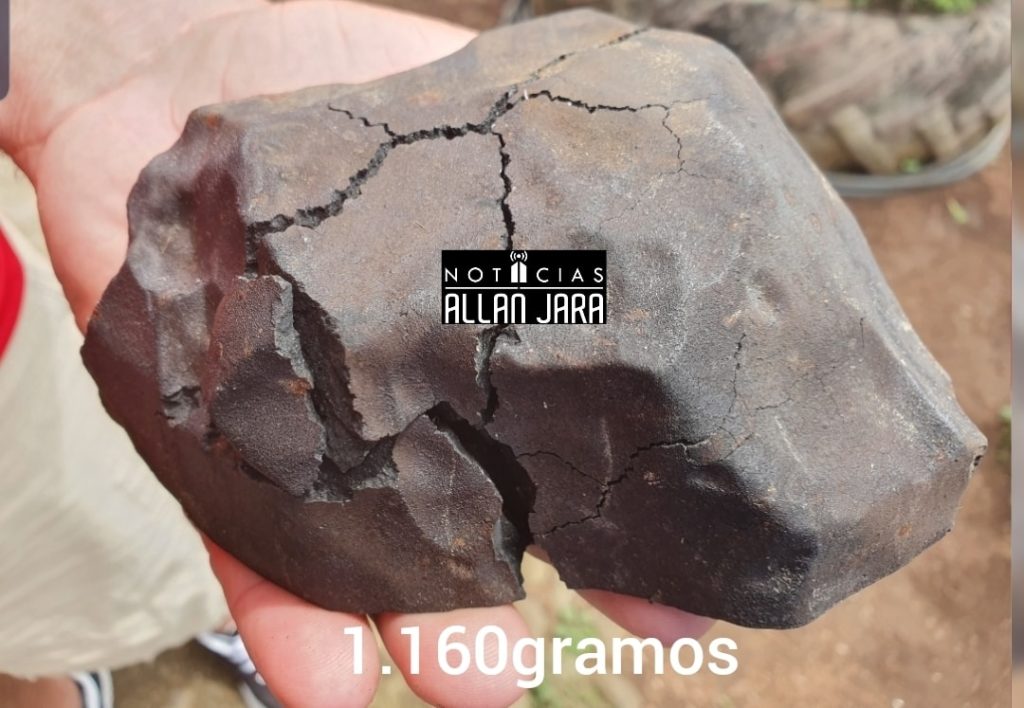
A complete but cracked 1160-gram specimen which was found after the rain on the first or second of May. Photo: Allan Jara
Other known meteorite specimens
The largest found mass of the fall is reported to weigh 1868 grams and is with the finder. A 280-Gramm specimen is reported to have hit a doghouse at location 10°24’9.35″N 84°21’51.26″W piercing a hole through its roof. This is about 234 meters away from the fall location of the 622-gram specimen on the concrete road.
The bolide
~ 9.07.22-26 p.m. CST, 23 April 2019 (~ 3.07.22-26 UTC, 24 April)
The preliminary atmospheric trajectory and pre-atmospheric orbit was calculated by teams from BRAMON* (Brazilian Meteors Observation Network), UNESP (São Paulo State University) and USP (University of São Paulo) based on four security camera and dashcam recordings (including the ones from San Ramón, Quepos, and Turrialba).
Approximate preliminary trajectory: WNW to ESE (towards azimuth ~117°), from above the approximate location ~10°28’39.69″N, 84°31’0.64″W to ~ 10°24’52.51″N, 84°23’25.65″W
Preliminary atmospheric trajectory:
Bolide’s entry angle: 73° relative to the ground.
Length of the luminous trail in the analysed 4-second interval: 20.7 km
Atmospheric velocity: 14 km/s.
Preliminary preatmospheric orbit:
Semi-major axis: 2.7 AU
Eccentricity: 0.63
Inclination: 3.09°
Pericenter longitude: 185.3°
Ascending node: 33.4°
The luminous trail in the moonless night sky was seen from San Carlos, Liberia, Paquera, San Rafael de Alajuela, San Rafael de Desamparados, Esparza, Cañas, and Santa Cruz among other places.
Luminous trail of the meteoroid recorded from location ~ 10.080952, -84.469620 in San Ramón (Radial de San Ramón, direction Plaza de Occidente, downtown San Ramón.) The camera location is about 37.3 km south-southwest of Caporal where the meteorite fell. Recorded with a Dash Cam YI, 2.7″ Screen Full HD 1080P60 165 Wide Angle. Video: Oscar Mario Alvarado Vasquez
Slow-motion animation of the fragmentation at the end of the luminous trail including the two main flares of the bolide as seen from San Ramón. The animation is purely for illustration purposes. Not every frame of the original footage has been used for the animation below. Original footage: Oscar Mario Alvarado Vasquez. Animation: karmaka CLICK ON THE IMAGE ON THE LEFT
Bolide and bolide’s main flare recorded by cameras of the Observatorio Vulcanológico y Sismológico of Costa Rica (Ovsicori) at Volcán Poás (about 24 km south-southeast of La Caporal) and Volcán Turrialba (about 75.5 km southeast of La Caporal). The Turrialba camera shown from 00:13 in the video above points at an azimuth of 270° from location 10.0192, -83.7564, the given time code in the frame is wrong, the main flare was captured at 21:07:44 (local time).Video: OVSICORI
Bolide recorded with a dash cam from Heredia. Video: Davie Avendano
The security cameras of a company at the Marina Pez Vela in Quepos, Puntarenas, about 109 km south-southeast of La Caporal, equally recorded the bolide.
Bolide recorded by a security camera located in Heredia, about 50 kilometers south-southeast of La Caporal. Video: Radio Columbia
Bolide recorded by a security camera pointing at the top of the Turrialba volcano in a northwestern direction. Video: Eduardo Hernandez
Bolide recorded by Cámeras Viales at the Rotonda de la Bandera in San José, about 59 kilometers south-southeast of La Caporal. Video: Cámeras Viales
Bolide recorded by a security camera. Video: Vivier Giovanni Vargas
Recording from an unknown location which seems to show the San Carlos bolide. Video provided by Rodolfo Brenes
Bolide’s reflection in a swimming pool recorded from somewhere in La Guácima, Alajuela, about 50 kilometers south to south-southeast from La Caporal
Bolide reflection on engine bonnet recorded by a camera in Grecia, about 35.5 kilometers almost south of La Caporal. Video: Daniel González Bolaños
Media:
Report about the second and third finds. Video: Noticias Repretel (25 April)
Literature:
Oscar H. Lücke, Pilar Madrigal, Gerardo J. Soto
Revista Geológica de América Central, Número 61 , 9-22; published: 11 December 2019
Ronnie Quintero-Quintero, Hairo Villalobos-Villalobos, Daniela Campos-Durán
Revista Geológica de América Central
Número 61 , 35-55; published: 2019-12-11
METEORITOS Y METEOROS EN COSTA RICA (VERDADEROS, POSIBLES Y FALSOS)
Gerardo J. Soto
Revista Geológica de América Central, 31: 7-23, 2004
“DISPUTAS POR PROPIEDAD
Me he preguntado varias veces sobre los derechos de propiedad de un meteorito que caiga en Costa Rica. Un meteorito es una roca y comotal, está compuesta de minerales. El Diccionario de Términos Geológicos del Instituto Geológico Estadounidense (Bates & Jackson, Eds., 1984) define un depósito mineral como “una masa de material mineral que ocurre naturalmente,… usualmente de valor económico, sin distingo de su modo de origen”. Parece lógico, en mi opinión, que entonces la “explotación” de un meteorito se rija por los principios de la Ley Nº 6797, el Código de Minería (1982), y el Decreto N° 29300-MINAE, Reglamento al Código de 20 REVISTA GEOLOGICA DE AMERICA CENTRAL Minería (2001) de los cuales se transcriben algunos artículos y notas, para discutir sus alcances, que por supuesto son interpretativos, pues no hay referencias explícitas a meteoritos. El artículo 1 del Código dice que “El Estado tiene el dominio absoluto, inalienable e imprescriptible de todos los recursos minerales que existen en el territorio nacional y en su mar patrimonial, cualquiera que sea el origen, estado físico o naturaleza de las sustancias que contengan… el Estado podrá otorgar concesiones para el reconocimiento, exploración, explotación y beneficio de los recursos minerales, conforme con la presente ley.” El Reglamento no define “recurso mineral”, pero sí “recurso indicado” en el acápite 44) del artículo 4°: “El que se estima que representa un interés económico intrínseco sobre la base de una exploración general que confirme las principales características geológicas de un yacimiento y que suministre una estimación inicial de sus dimensiones, forma, estructura y contenido”. Luego, el artículo 27 del Código escribe: “El respectivo Ministerio podrá otorgar directamente una concesión de explotación, sin necesidad de exigir el cumplimiento previo de la etapa de exploración, cuando los minerales estén a la vistao sea evidente su existencia, previa elaboración y
aprobación del correspondiente proyecto de explotación”. Explotación está definido en el acápite 21) del artículo 4° del Reglamento: “Extracción de minerales de un yacimiento de acuerdo a técnicas mineras de superficie o subterráneas”. Además, el artículo 39 del Código: “Los yacimientos de placer ubicados en terrenos baldíos o en el lecho mismo de un río o quebrada, sobre los cuales no hubieran derechos mineros previos, podrán ser aprovechados libremente, siempre que el lavado se efectúe a mano.” Y el artículo 41 del Código: “Cuando un yacimiento de placer se encuentre en un terreno cercado y éste sea de dominio privado, el propietario será el que tenga prioridad para efectuar los trabajos de aprovechamiento, pero deberá reconocer un porcentaje de la explotación del yacimiento a quien lo hubiese descubierto; tal reconocimiento se hará de acuerdo con el estudio técnico que deberá realizar la Dirección de Geología, Minas e Hidrocarburos.” A pesar de que un meteorito es de procedencia extraterrestre, es un recurso mineral que tiene un valor económico de mercado definido internacionalmente según su tipo, y si cayó en el pasado, o si cae en algún momento, se encuentra en el territorio nacional. Por tanto, según el artículo primero transcrito, independientemente de su origen o naturaleza, el Estado tiene dominio sobre él, pero no su propiedad. Aunque estrictamente hablando, un meteorito no es un yacimiento de placer, se comporta como tal: está suelto y a la vista, parcialmente enterrado, a lo sumo. Han de tomar en cuenta no sólo los pequeños meteoritos de algunos g ó kg de peso, que pueden ser una o varias piezas, sino la posibilidad de que caiga algún día un meteorito grande, que se fragmente y forme todo un campo de caída, con especímenes de gran tonelaje. En el caso de los especímenes pequeños, se puede aplicar el artículo 39, de modo que basta tomarlos con la mano, y pueden ser aprovechados libremente por su descubridor, siempre que sea en terrenos baldíos, o bien en propiedad privada, por su dueño. En caso de ser piezas de gran tamaño, o múltiples, podrá el dueño explotarlo con base en el artículo 41. Pero si algún científico, o cualquier otra persona lo descubren, podrá hacer uso de este mismo artículo para exigir su parte. A lo sumo, necesitarían cumplir el artículo 27. Es solo mi interpretación, pues no hay precedentes en Costa Rica. Cito un antecedente histórico en el extranjero: En Estados Unidos, debido a un sonado caso ocurrido en 1902, cuando un individuo descubrió y extrajo secretamente un meteorito de 12 700 kg
de una propiedad, pero luego fue demandado por los dueños del terreno para reposeer la roca, existe el precedente legal de que un meteorito pertenece al dueño del terreno sobre el cual cayó (McSween, 1999; pág. 10).”
















